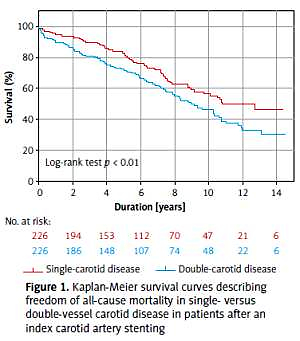Current issue
Archive
Manuscripts accepted
About the Journal
Editorial office
Editorial board
Section Editors
Abstracting and indexing
Subscription
Contact
Ethical standards and procedures
Most read articles
Instructions for authors
Article Processing Charge (APC)
Regulations of paying article processing charge (APC)
ATHEROSCLEROSIS / CLINICAL RESEARCH
Long-term survival of carotid stenting patients with
regard to single- or double-vessel carotid artery
disease: a propensity score matching analysis
1
Department of Cardiology, 2nd Medical School, Charles University, University Hospital Motol, Prague, Czech Republic
Submission date: 2020-04-03
Final revision date: 2020-07-18
Acceptance date: 2020-07-18
Online publication date: 2020-08-17
Publication date: 2021-07-16
Arch Med Sci 2021;17(4):849-855
KEYWORDS
TOPICS
ABSTRACT
Introduction:
There is lack of long-term data outside of controlled clinical trials in carotid artery stenting (CAS). In this study, we compared the short-term outcome, long-term survival, and rate of re-interventions for restenosis in patients after CAS, related to the extent of carotid atherosclerosis classified as single-vessel (unilateral) or double-vessel (bilateral) carotid artery disease.
Material and methods:
We retrospectively evaluated 599 patients with significant carotid artery stenosis, who underwent 763 CAS procedures, and used the propensity score to match 226 pairs (452 patients) in the single- or double-vessel carotid disease.
Results:
There was no significant difference in the occurrence of in-hospital major adverse events (3.5% vs. 3.1% of patients in the double-vessel carotid group vs. the single-vessel carotid group; p = 1) The mean follow-up was 6.1 ±4.0 years, and a total of 181 (40%) deaths occurred during 2759 patient-years, which translates into 7.8 and 5.3 deaths per 100 patient-years in the double-vessel carotid group and the single-vessel carotid group, respectively (p < 0.01). The survival in the double-vessel carotid group vs. the single-vessel carotid group at 10 years was 46% (95% CI: 38–54%) vs. 55% (95% CI: 47–63%) (p < 0.01). Twenty-four (11%) patients and 6 (3%) patients underwent re-interventions for restenosis in the double-vessel and the single-vessel carotid disease group, respectively (p < 0.01).
Conclusions:
Patients with CAS and significant double-vessel carotid artery disease had similar peri-procedural risk, but had a worse long-term survival, and a higher rate of re-interventions for restenosis compared to the single-vessel carotid artery disease patients.
There is lack of long-term data outside of controlled clinical trials in carotid artery stenting (CAS). In this study, we compared the short-term outcome, long-term survival, and rate of re-interventions for restenosis in patients after CAS, related to the extent of carotid atherosclerosis classified as single-vessel (unilateral) or double-vessel (bilateral) carotid artery disease.
Material and methods:
We retrospectively evaluated 599 patients with significant carotid artery stenosis, who underwent 763 CAS procedures, and used the propensity score to match 226 pairs (452 patients) in the single- or double-vessel carotid disease.
Results:
There was no significant difference in the occurrence of in-hospital major adverse events (3.5% vs. 3.1% of patients in the double-vessel carotid group vs. the single-vessel carotid group; p = 1) The mean follow-up was 6.1 ±4.0 years, and a total of 181 (40%) deaths occurred during 2759 patient-years, which translates into 7.8 and 5.3 deaths per 100 patient-years in the double-vessel carotid group and the single-vessel carotid group, respectively (p < 0.01). The survival in the double-vessel carotid group vs. the single-vessel carotid group at 10 years was 46% (95% CI: 38–54%) vs. 55% (95% CI: 47–63%) (p < 0.01). Twenty-four (11%) patients and 6 (3%) patients underwent re-interventions for restenosis in the double-vessel and the single-vessel carotid disease group, respectively (p < 0.01).
Conclusions:
Patients with CAS and significant double-vessel carotid artery disease had similar peri-procedural risk, but had a worse long-term survival, and a higher rate of re-interventions for restenosis compared to the single-vessel carotid artery disease patients.
Share
RELATED ARTICLE
We process personal data collected when visiting the website. The function of obtaining information about users and their behavior is carried out by voluntarily entered information in forms and saving cookies in end devices. Data, including cookies, are used to provide services, improve the user experience and to analyze the traffic in accordance with the Privacy policy. Data are also collected and processed by Google Analytics tool (more).
You can change cookies settings in your browser. Restricted use of cookies in the browser configuration may affect some functionalities of the website.
You can change cookies settings in your browser. Restricted use of cookies in the browser configuration may affect some functionalities of the website.



